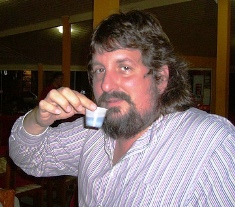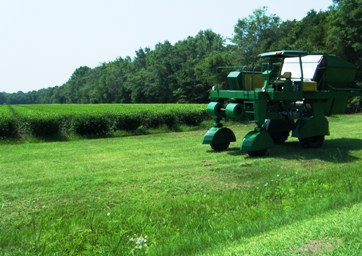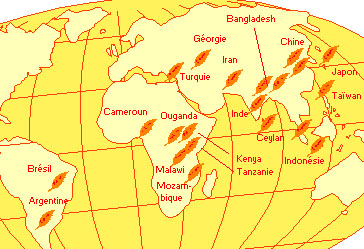| Geography of Tea James Hayes-Bohanan , Ph.D. Bridgewater State University Geography Vanderbilt University Institute for Coffee Studies UPDATED July 22, 2010  It was bound to
happen: My obsession with the geography
of coffee has inevitably led to the geography
of tea. For several years, people would ask me why I do not teach about
tea, and my answer would be quite simple: I did not know anything about
it. I did know, however, that the two beverages have a lot in common,
and that some in the fair-trade movement were beginning to develop
relationships with tea growers. It was not until I was approached about
a book project, however, that I began to take the matter of tea
seriously enough to begin my own explorations. It was bound to
happen: My obsession with the geography
of coffee has inevitably led to the geography
of tea. For several years, people would ask me why I do not teach about
tea, and my answer would be quite simple: I did not know anything about
it. I did know, however, that the two beverages have a lot in common,
and that some in the fair-trade movement were beginning to develop
relationships with tea growers. It was not until I was approached about
a book project, however, that I began to take the matter of tea
seriously enough to begin my own explorations. |
 Enjoying that other beverage in Brazil (until I get a better photo for this page) |
|
I
would
love
to
speak about
coffee or tea
to your school or civic organization!
|
|
Common Grounds
(Borrowing an over-worked phrase in the coffee field.)
View Larger Map
 That's right: South
Carolina. In June 2010, I actually had a chance to visit a tea garden
in the United States. South Carolina once had several, but they were
not economically viable. An example of domestic agro-tourism, the
Charleston Tea Plantation is now operated by Bill Hall under and
agreement with Bigelow, and is also known
as "Bigelow's Tea
Garden." We took a private tour with Mr. Hall and some of our
friends from the Charleston area came along. I was able to solve a
geographic question I had before the visit: how can good tea (and by
all
accounts this is good tea, even being served at the White House) can
grow at sea level, when most fine teas grow much, much higher? I
confirmed that the tea is indeed excellent and learned the answer to
that question, which I report on my South
Carolina page.
That's right: South
Carolina. In June 2010, I actually had a chance to visit a tea garden
in the United States. South Carolina once had several, but they were
not economically viable. An example of domestic agro-tourism, the
Charleston Tea Plantation is now operated by Bill Hall under and
agreement with Bigelow, and is also known
as "Bigelow's Tea
Garden." We took a private tour with Mr. Hall and some of our
friends from the Charleston area came along. I was able to solve a
geographic question I had before the visit: how can good tea (and by
all
accounts this is good tea, even being served at the White House) can
grow at sea level, when most fine teas grow much, much higher? I
confirmed that the tea is indeed excellent and learned the answer to
that question, which I report on my South
Carolina page.
See more at my main tea page, and come back often. As of early 2010, I am just beginning my tea research.
(Borrowing an over-worked phrase in the coffee field.)
| Coffee and tea are not botanically
close relatives and they do not grow in the same environments, but
their common
locations are similar enough in very broad terms that some countries
are significant producers of both. Generally, both are found in highland areas in tropical latitudes -- the former colonies of the Global South. The top twenty producers of tea are listed to the right, with recent production in metric tons. Those countries listed in bold are also major producers of coffee. Patterns of consumption offer some interesting comparisons. The former colonial and post-colonial powers of the Global North are major consumers of both beverages. A key difference, though, is that whereas most major producers of coffee are not major consumers (Brazil being the most notable exception), most of the major tea producers are also major consumers. It is for this reason that trade in coffee is greater than it is for tea, even though the latter has much more production. Coffee and tea have far more in common than coincident locations. What makes the two beverages intersting for a geographer is a common set of other features. For example, patterns of vertical integration in the commerce -- including the unequal distribution of benefits between producers and intermediaries -- are quite similar. It is for this reason that some fair-trade companies and organizations -- such as Equal Exchange -- have begun to add tea to their offerings. As with cocoa, coffee, and perhaps some other beverages, moving tea from the field to the cup requires some processing that must occur almost immediately after harvesting, so that a variety of factories or mills must be operated in the producing countries. An important components of the fair-trade movement in each case, therefore, is finding ways to give producers some control over these processes.  Both coffee and tea
are generally sold as blends that are uniform over
time and that might include a mix of product from several, different
countries. In both cases, however, markets are emerging for beverages
with distinctive tastes profiles associated with specific geographic
regions. Because connoisseurs are willing to pay a premium for such
distinctive coffees and teas, specialty marketing has emerged as a
potentially important economic factor for some producers of both
beverages. Both coffee and tea
are generally sold as blends that are uniform over
time and that might include a mix of product from several, different
countries. In both cases, however, markets are emerging for beverages
with distinctive tastes profiles associated with specific geographic
regions. Because connoisseurs are willing to pay a premium for such
distinctive coffees and teas, specialty marketing has emerged as a
potentially important economic factor for some producers of both
beverages.The Tea Map page from the Republic of Tea describes some of the differences among teas in the historically most important areas of Asia. The World Tea Tour from Coffee Tea Warehouse is another good overview, with this attractive map and some interesting regional distinctions within the larger countries. |
|
Kenya
View Larger Map
South Carolina
 That's right: South
Carolina. In June 2010, I actually had a chance to visit a tea garden
in the United States. South Carolina once had several, but they were
not economically viable. An example of domestic agro-tourism, the
Charleston Tea Plantation is now operated by Bill Hall under and
agreement with Bigelow, and is also known
as "Bigelow's Tea
Garden." We took a private tour with Mr. Hall and some of our
friends from the Charleston area came along. I was able to solve a
geographic question I had before the visit: how can good tea (and by
all
accounts this is good tea, even being served at the White House) can
grow at sea level, when most fine teas grow much, much higher? I
confirmed that the tea is indeed excellent and learned the answer to
that question, which I report on my South
Carolina page.
That's right: South
Carolina. In June 2010, I actually had a chance to visit a tea garden
in the United States. South Carolina once had several, but they were
not economically viable. An example of domestic agro-tourism, the
Charleston Tea Plantation is now operated by Bill Hall under and
agreement with Bigelow, and is also known
as "Bigelow's Tea
Garden." We took a private tour with Mr. Hall and some of our
friends from the Charleston area came along. I was able to solve a
geographic question I had before the visit: how can good tea (and by
all
accounts this is good tea, even being served at the White House) can
grow at sea level, when most fine teas grow much, much higher? I
confirmed that the tea is indeed excellent and learned the answer to
that question, which I report on my South
Carolina page.Tea and Conflict
Thanks to my colleagues at the Polus Center for Social and Economic Development, I have become accutely aware of the all-too common problem of landmines that have been deployed in coffee-growing areas. I am not yet aware of any connections between landmines and tea, but I am doing some preliminary research to see whether such connections may exist. As a starting point, I have identified thirteen countries among the top-twenty producers of tea that also have significant landmine problems. These are indicated by astrisks (*) in the list above. I am very interested in hearing from those with more detailed knowledge tea production or landmine problems, to see if tea-producing areas are themselves involved.
See more at my main tea page, and come back often. As of early 2010, I am just beginning my tea research.
